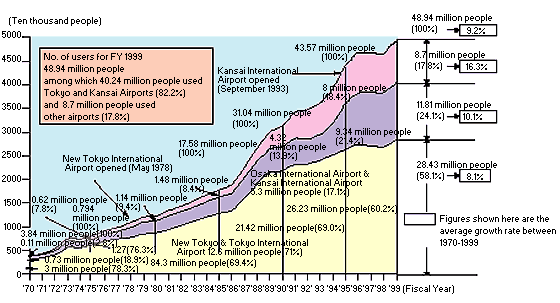| With regards to more substantial present expressway
bus transport, which expanded its network in conjunction with extensions
to major expressways, it is now necessary for this mode of transport to
improve its level of convenience by going ahead with the construction of
park and bus ride parking and bus terminals in addition to answering the
diverse needs of users of such transport. Furthermore, in recent years competition
in modes of transportation including expressway bus, air and rail transport
for mostly mid-range distances has intensified due to the increase of rail
travel speed and the cheapness of airline fares. Consumers are now not only
sensitive to speed and convenience, but also to price levels. Through this
type of competition, it is hoped that a generally high level of service
is provided. 4. International Air Passenger Transport For Japan, an island country located in the far east which continues to increase mutual dependence with foreign countries in terms of socio-economic activities, it is appropriate to say that well established international transport modes are indeed a lifeline essential to the country's existence. In recent years, international passenger transport has increased at a consistent level supported by an increase in demand focused mainly on Japanese nationals. This trend will continue in the 21st century, although not to the same extent in terms of volume increases as seen until now. |
Changes in International Air Passenger Transport Volume |
 |
| The number of international
flight passenger has consistently increased up until now. Even by long-term
transport demand forecasts set by the Council for Transport Policy, an
increase of 59% to 79% in comparison to 1995 is expected for 2010. Furthermore, while the number of users of four major airports of Narita, Haneda, KIX and Itami make up the majority, the actual growth rate of other airports is higher than these four. |
| International airports are deeply connected with the
international competitiveness and functions of cities. As such, securing
sufficient capacity to respond to an array of needs is vital. However,
it is a fact that the base airports in Japan's major cities have not been
able to respond to the increase in demand by increasing the number of
flights and are being rushed to conduct the necessary construction. Above
all, while a large number of countries wish to be able to fly into these
airports, the increase in capacity of these airports that can not respond
to the present demands due to insufficient slots is becoming an urgent
necessity. In addition, more effort to make the level of service internationally
equal by progressing with improvements in airport access. The advancement of globalization will in turn activate competition between airlines and thus improve the level of air transport service. This does not merely refer to the competition between Japanese companies themselves or with foreign companies, but it means that as collaborations and tie-ups that go beyond national borders advance, so too does competition among the different tie-up groups intensify. As such, users then reach the stage at which they will select the airline based not on nationality but on the quality of service and price. To that end, improvements in connections between domestic and international flights, and international-to-international flights at the base airports in the major cities as well as efforts to advance environment focused construction that sees a diverse array of services through tie-ups between airline companies advance are necessary. This kind of situation then produces the issue of how Japanese airline companies can improve their international competitiveness. Furthermore, improvements in the fulfillment of guidance through signs and foreign languages in response to increases in the number of foreign visitors to Japan become necessary too. |
|
|
PREVIOUS |
|
TOP |
|